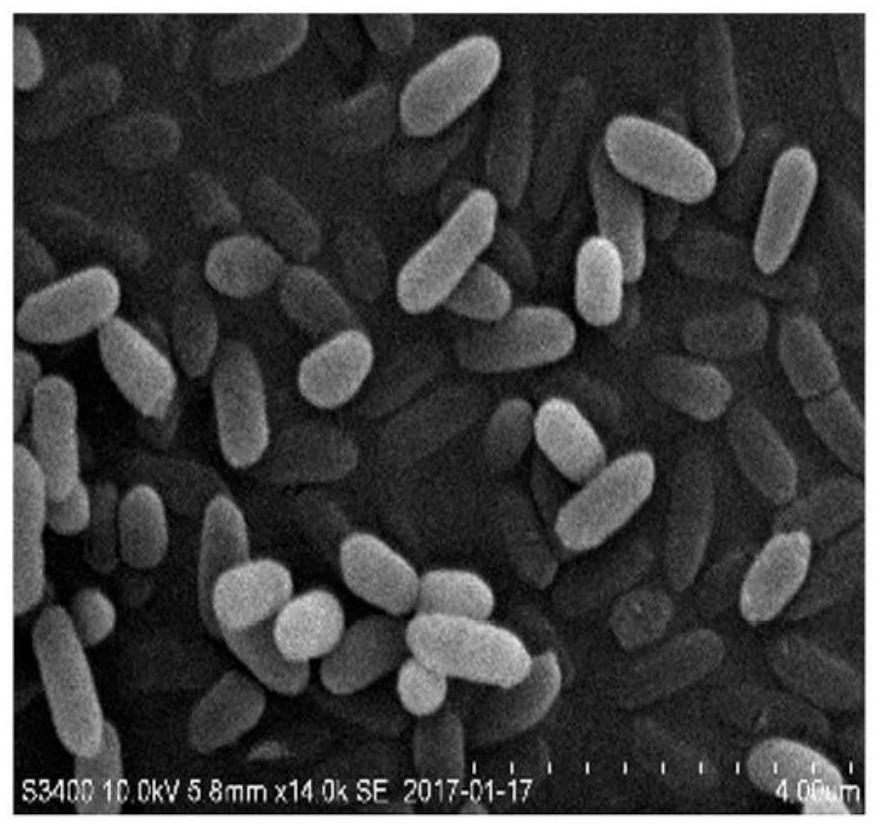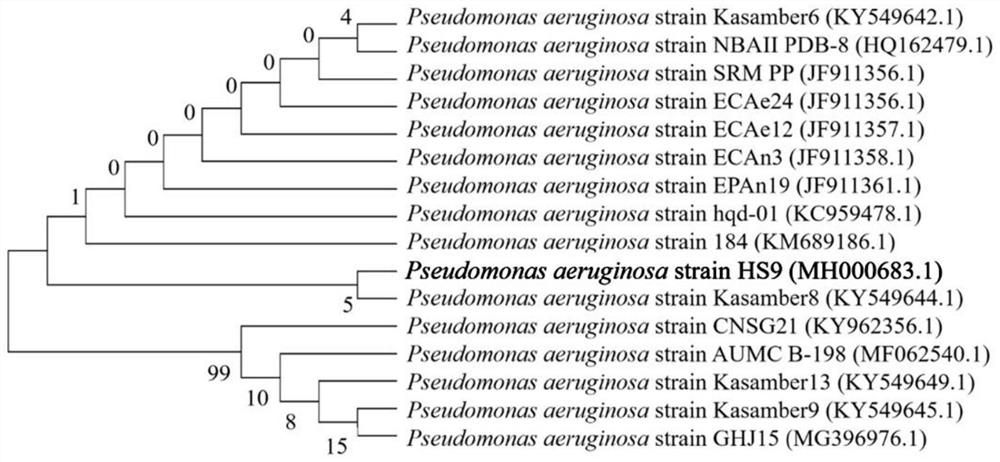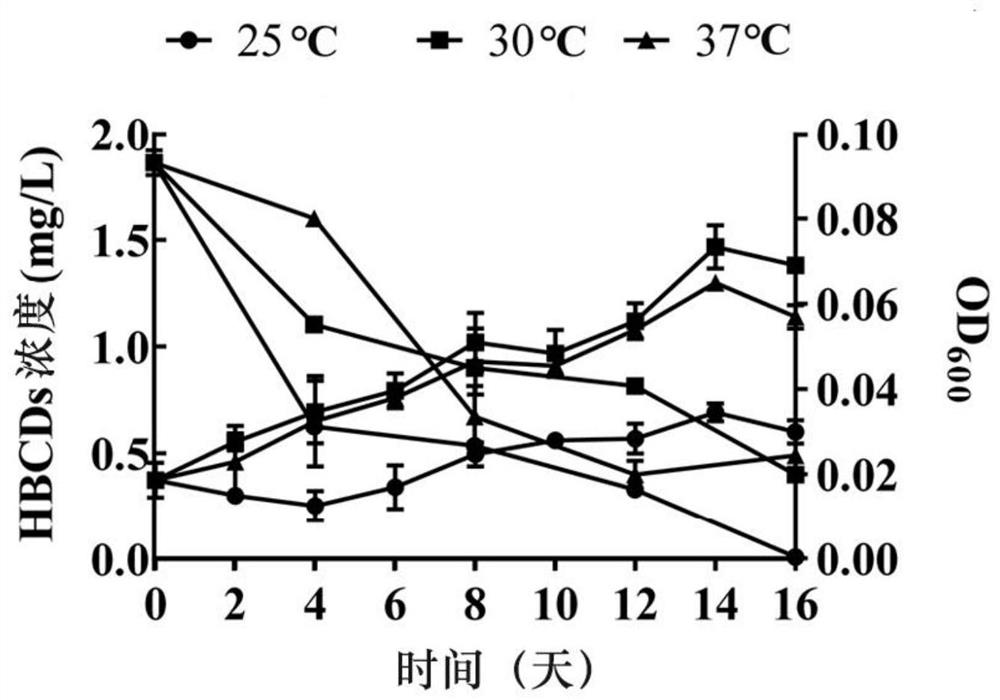A Hexabromocyclododecane Degrading Strain and Its Application in Environmental Remediation
A technology of hexabromocyclododecane and bacterial strain, which is applied in the field of environmental biology and achieves the effects of mild reaction conditions, low cost and energy saving
- Summary
- Abstract
- Description
- Claims
- Application Information
AI Technical Summary
Problems solved by technology
Method used
Image
Examples
Embodiment 1
[0047] Example 1 Isolation and identification of Pseudomonas aeruginosa HS9 and its degradation characteristics of HBCDs
[0048] 1. Screening and isolation of strains
[0049] 1) Take a sample
[0050] Soil sample collection location: Laogang Industrial Zone, Shanghai.
[0051] 2) Screening and isolation of strains
[0052] Dissolve a total of 10 g of soil samples collected from different depths in 50 mL of distilled water, shake on a vortex shaker for 5 minutes, take 5 mL of soil solution, add it to 50 mL of inorganic salt liquid medium, and culture at a temperature of 30 °C and a speed of 200 rpm. Minutes for 10 days. After 3 to 4 passages, the culture solution was diluted and spread on the inorganic salt solid slant medium added with 1.0 mg / L HBCDs, and cultured at 30° C. for 5 to 10 days. Pick a single colony into a fresh inorganic salt liquid medium, select the fastest-growing strain for streak isolation, and repeat several times until a purified single bacterium is ...
Embodiment 2
[0067] Example 2 Analysis of intermediate metabolites of Pseudomonas aeruginosa HS9 degrading HBCDs
[0068] 1. Culture of Pseudomonas aeruginosa HS9
[0069] Inoculate 15 mL of bacterial suspension into 1 L of MSM liquid medium containing HBCDs (1.0 mg / L), culture at 30° C., and rotate at 200 rpm. When the growth of the strain entered the late plateau stage, the cells were collected for resting cell reaction.
[0070] Add HBCDs (1.0mg / L) as a substrate to stop the cell reaction. During the reaction for 0 to 24 hours, take 10 mL of the culture, centrifuge at 8,000 rpm for 10 minutes at 4°C, and collect the supernatant. Extraction for subsequent gas chromatography-mass spectrometry (GC-MS) and HPLC-MS analysis.
[0071] 2. Sample preparation process and chromatographic conditions
[0072] 1) Sample preparation
[0073] Add 10 μL HCl to 1 mL sample to terminate the reaction, to reduce the low extraction effect caused by adsorption. After shaking with a vortex shaker for 30 ...
Embodiment 3
[0081] Example 3 Simulation application of Pseudomonas aeruginosa HS9 in environmental restoration
[0082] Because the actual pollution environment is usually relatively harsh, therefore, in order to simulate the application of Pseudomonas aeruginosa HS9 to remove HBCDs in wastewater, the adaptation range of the bacterial strain to the culture temperature and the initial pH of the culture solution has been tested (initial HBCDs concentration 1.7mg / L, 200 rpm shaking culture). Such as image 3 As shown, the strains can degrade HBCDs rapidly when the culture temperature is 25°C-37°C. Such as Figure 4 As shown, the strains can degrade HBCDs rapidly in the inorganic salt liquid medium with a pH value of 6.0-8.0. Among them, when the pH value was 7.0, the degradation rate of HBCDs was the fastest; when the pH value was 6.0 or 8.0, the strain's degradation rate of HBCDs decreased. Under the optimum conditions of 30°C and pH 7.0, such as Image 6 In the simulation application ...
PUM
 Login to View More
Login to View More Abstract
Description
Claims
Application Information
 Login to View More
Login to View More - R&D
- Intellectual Property
- Life Sciences
- Materials
- Tech Scout
- Unparalleled Data Quality
- Higher Quality Content
- 60% Fewer Hallucinations
Browse by: Latest US Patents, China's latest patents, Technical Efficacy Thesaurus, Application Domain, Technology Topic, Popular Technical Reports.
© 2025 PatSnap. All rights reserved.Legal|Privacy policy|Modern Slavery Act Transparency Statement|Sitemap|About US| Contact US: help@patsnap.com



